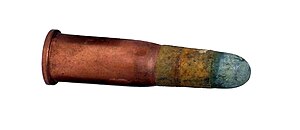10.4 mm Vetterli
| 10.4 mm Vetterli | |
|---|---|

|
|
| general information | |
| caliber | 10.4 mm Vetterli |
| Sleeve shape | Bottle neck sleeve with rim |
| Dimensions | |
| Sleeve shoulder ⌀ | 13.4 mm |
| Sleeve neck ⌀ | 11.4 mm |
| Floor ⌀ | 10.5 mm |
| Cartridge bottom ⌀ | 15.8 mm |
| Sleeve length | 38 mm |
| Cartridge length | 56 mm |
| Weights | |
| Bullet weight | 20.13 g |
| Powder weight | 4 g |
| total weight | 30.4 g |
| Technical specifications | |
| Speed v 0 | 435 m / s |
| Lists on the subject | |
The 10.4 mm Vetterli cartridge (US designation .41 Swiss) was a rimfire cartridge that was used in the Vetterlige rifle from 1869 until the introduction of the Schmidt Rubin rifle model 1889 in caliber 7.5 × 53.5 mm (GP1890) Swiss orderly cartridge was used. It was officially sold as a metal cartridge Cal. 10.4 m / m .
history
Ammunition with the same dimensions was already used with a slightly weaker charge in the single-shot Milbank-Amsler model 1851–1867 and the Peabody rifle imported from America . In the cousin rifle and its variants, the carbine, the socket and the short rifles for the police and border guards, it was used well into the 20th century.
technology
The ammunition fired by the cousin rifle was black powder cartridges with full lead bullets and bottle neck-shaped cases made of tombac (94% copper, 6% zinc) with rim ignition. Except for the somewhat heavier charge, they corresponded to the cartridges for the single-shot Milbank-Amsler and Peabody . Shot cartridges were occasionally handed in, and there was also a fire bullet known as GP 1867 . Manipulation cartridges were given to the troops for exercise, which can be recognized by a groove in the case.
The effective bullet caliber was 10.8 mm. Despite this bullet diameter, the caliber of the Vetterlimunition was given as 10.4, which corresponded to the normal caliber of the later Vetterli rifles. The bullet had a cavity at the back in the manner of a Minié bullet , which expanded due to the gas pressure and thus resulted in better guidance of the bullet in the trains.
The powder charge of the Vetterlipartone was 4 g, it could also be fired safely with the earlier single-shot Milbank-Amsler 1851–1867 and Peabody (charge of the earlier cartridge 3.6 g black powder, bullet 20.4 g). With a V 0 of 435 m / s, shot from the infantry rifle, the maximum firing range was 2800 m.
The centerfire hunting cartridges had the same gunpowder charges as the military ammunition, brass cases and mostly half-jacket bullets.
The load for the cadet rifle was only 3 g in order to reduce the recoil of the lighter weapon to a level tolerable for young people.
Due to the unsatisfactory performance of the cartridge from the carbines, its shape was adapted to the cartridge chamber in 1871 (rifle cartridge 71). In 1878 the lead bullet was replaced by one with paper wrapping (rifle cartridge 78). In 1890 there was a switch to low-smoke powder (nitro powder) (rifle cartridge 90). The Eidgenössische Munitionsfabrik Thun manufactured the cartridge until 1942.
literature
- Clement Bosson: Poor individual you Soldat Suisse. Editions Pierre-Marcel Favre, Lausanne, ISBN 2-8289-0035-5 .
- Brigadier Haug: KMG IMG 1850–1975 The History of War Material Management. Liebefeld, Bern 1977.
- Rudolf Schmidt: Les Armes Suisses à Répétition (Vetterli System) H. Georg, Libraire Editeur Bâle et Genève 1870.
Individual evidence
- ↑ Wolfgang Finze: What am I? Swiss Rifle (= visor . No. 4 ). 2009, p. 120–129, here p. 123 .
Web links
- The Swiss Service Cartridges. In: Swiss Handguns 1882. www.swissrifles.com, accessed on January 7, 2018 (English).
- The ammunition for weapons according to the Vetterli system (development history) at ch-munition.ch


